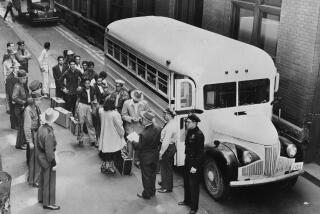A simple tribute pays homage to Marines who died far away but are not forgotten.
- Share via
As war statues go, the Tarawa monument is simple: a 9-ton rectangular granite slab with polished brass plaques on two sides.
It pays homage to men who died valiantly in a World War II battle far away on the Pacific atoll of Tarawa.
The Tarawa monument is rekindling emotions and patriotism this week, 45 years after the atoll’s lagoon turned red from the blood of the 1,118 Marines who died storming the beaches and routing the Japanese from their fortifications.
The monument on the Promenade in downtown Long Beach has been one of the biggest draws of the 10-day citywide centennial celebration. More than 500 gathered for a dedication last Friday and a memorial service on Saturday, and visitors continued to stream by early this week.
Onlookers stood in silent tribute. Some wept. One serviceman was seen saluting, kneeling in silent prayer, then quietly leaving.
Tom Hennessy, the Long Beach Press-Telegram columnist who spearheaded the collection drive for the monument three years ago, said a woman deposited two roses at the base of the granite edifice. She told the veteran honor guard that the roses were from a back yard bush planted by her brother, a Marine killed in action at Tarawa.
Marine buddies who had not seen each other since the war visited the monument and, in a few chance meetings, renewed old friendships. Veterans of the 2nd Marine Division from as far away as Mississippi and Florida came to honor their fallen comrades.
Barbara Benson, 70, came to the monument to honor her brother, Edwin F. Benson. He contracted malaria in Panama and could have sat out the war, his sister said. He chose to stay on active duty, a decision that cost him his life at Tarawa.
“It has meant a lot to me. It is a wonderful tribute,” Benson said. Accompanied by her neighbor, Helen Billis, Benson took photographs of her brother’s name on a roster of the dead near the monument for herself and her sister in Huntington Beach.
Joan Livingston, a librarian from Seal Beach, brought a little African violet to lay at the base of the monument that was already ankle-deep in flowers.
She said she was born after the war, but was stirred by what she had read about the monument and wanted to do her part.
“I wanted them to know their sacrifice was not in vain,” said Livingston, who came with her friend, John Price.
The monument, built with $18,000 donated by Long Beach residents, was being guarded around the clock by veterans and active duty servicemen.
Veterans participating in the honor guard said they have been moved by the kind reaction of people and by the resurgence of American pride.
“I think it’s impressive,” said Marty Martin, 67, of San Diego, a veteran of the famed Merrill’s Marauders unit that fought behind Japanese lines during World War II. “It’s something to bring back Americanism to young people.”
Frank Brittain, 65, of Chula Vista said that the monument is a way of telling the relatives of the deceased Marines that their country still mourns the loss. He said he has seen those emotions etched in the faces of onlookers.
“I’ve seen guys come up here and salute with tears in their eyes,” said Brittain, a Navy frogman in World War II and an Army ranger during the Korean War.
Alex Andres, a U.S. Army soldier who survived the Bataan Death March in the Philippines and was a prisoner of war, was serving in the monument honor guard with other members of the American Ex-Prisoners of War.
“I think this symbolizes freedom, liberty and democracy,” said Andres, 69, of Rancho Palos Verdes.
The monument will remain on display during the 10-day centennial celebration. It eventually will be flown to a permanent site on Tarawa. It will replace another monument that was torn down to make way for a Japanese cold storage plant.
More to Read
Sign up for Essential California
The most important California stories and recommendations in your inbox every morning.
You may occasionally receive promotional content from the Los Angeles Times.










